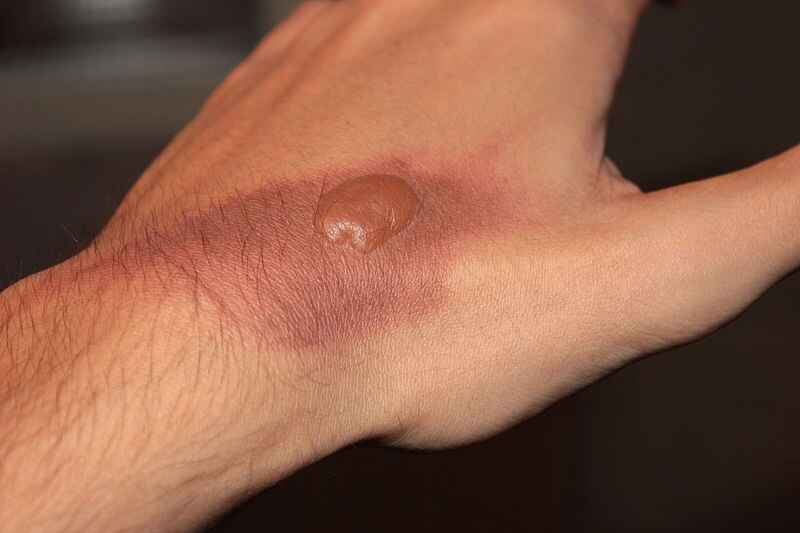5 Dangers of Infrared Waves Explained
Dangers of infrared waves are; skin damage, hemorrhaging, cataract formation, vision loss (scotoma), and DNA damage.
This article discusses the dangers of infrared waves, as follows;
1). Skin Damage (as one of the Dangers of Infrared Waves)
When infrared waves hit the skin, they penetrate through the dermal layers, and cause increase in thermal energy or heat.
Infrared radiation passes through skin easily, through contactless energy transfer, penetrating various skin layers that include the epidermis and dermis, as well as subcutaneous tissues [2]. The exact extent and manner of penetration differs with infrared source, energy intensity and wavelength.
Damages caused by infrared to the skin are mainly related to thermal alteration and malformation of organic cells and tissues. These effects mostly occur with overexposure to infrared waves from natural sources like solar radiation, as well as artificial sources like heating devices.
Harmful effects of infrared rays on the skin are; elastin and collagen damage/degradation, dehydration, and inflammation; all of which may be observed in the form of wrinkles, loss of skin tone and clarity, and thermal injuries like scalds, burns and ulcers.
In terms of premature ageing, overexposure to infrared radiation has similar effect as overexposure to ultraviolet rays.
The heating effect of infrared also multiplies tryptase, and mast cells in the human skin, which are responsible for releasing histamine hormone that causes the body's immune response to stimuli, and can result in severe inflammation of the skin [4].

2). Hemorrhaging
Infrared radiation indirectly causes hemorrhaging of the skin and eyes, through conditions like Erythema ab igne (EAI) and telangiectasias.
Another name for Erythema ab igne is hot water bottle-rash, or toasted skin-condition. It is a localized, subcutaneous condition whose causes include long-term overexposure to infrared radiation.
Infrared erythema ab igne is usually observed in the form of symptoms like hyperpigmentation, reticulate erythema, epidermal atrophy, telangiectasias, and epidermal atrophy [3].
Telangiectasias (or spider veins), which is a symptom of erythema ab igne; is characterized by the presence of multiple widened, small blood vessels on the skin [8]. One of the risks associated with telangiectasis is blood vessel rupturing and hemorrhaging.
Exposure to artificial infrared sources like lamps can cause erythema ab igne, alongside other sources of infrared radiation [5].
3). Cataract Formation (as one of the Dangers of Infrared Waves)
One of the most common, harmful effects of infrared waves on humans is the formation of cataracts in the eyes.
Infrared radiation causes eye cataracts with prolonged, repeater and high-intensity exposures.
Too much exposure to infrared waves causes cataracts because the proteinous components of the lens are heat-sensitive and can undergo significant malformation when subjected to intense heat [1].
Occupational exposure is a common reason for the formation of heat-induced cataracts in humans. This may be observed among workers in glass-making and metal-smelting industries, where long-term facial exposure to extreme heat is common. For the same reason, cataracts caused by infrared waves are often referred to as 'glassblower's cataracts'.

4). Vision Loss
Vision loss, or scotoma, is one of the cumulative potential effects of infrared waves on humans.
Scotoma itself is a condition involving partial or total loss of visual activity in some parts of the eye to to retinal damage. It may lead to complete loss of vision when it affects the central part of the eye.
Studies have shown that scotoma is a possible outcome of overexposure to infrared waves, even from artificial sources like heaters [7]. It may occur as a secondary development after the formation of heat-induced cataracts.
Protecting the eyes from retinal damage by infrared, can be achieved using sun filters [9].
5). DNA Damage (as one of the Dangers of Infrared Waves)
Infrared affects DNA in diverse ways, which range from suppression and inhibition to exacerbation.
Generally, the type of electromagnetic radiation that is known to cause DNA damage is ionizing radiation; which included Gamma Rays and X-rays. However, certain intensities of non-ionizing waves like ultraviolet and infrared, can also contribute to the damage and alteration of DNA in organic cells.
Near infrared (NIR) can damage DNA significantly under high-intensity conditions, and its ability to cause such damage is exploited in the treatment of cancer, through cancer cell-DNA destruction [10].
When cells are exposed to high energy infrared, their DNA structures can be altered, which could result in unfavorable genetic conditions.
One of the uses of infrared is radiotherapeutic treatment, because of the tendency of controlled IR exposure to improve blood circulation and metabolism.
Studies show that the use of infrared to reduce UV-induced DNA damage by rejuvenating cells destroyed by ultraviolet radiation and reducing apoptosis, can result in the survival of damaged cells and increase the risk of cancer in patients [6].
Conclusion
The dangers of infrared waves are;
1. Skin Damage
2. Hemorrhaging
3. Cataract Formation
4. Vision Loss
5. DNA Damage
References
1). Aly, E. M.; Mohamed, E. S. (2011). "Effect of infrared radiation on the lens." Indian J Ophthalmol. 2011 Mar-Apr;59(2):97-101. Available at: https://doi.org/10.4103/0301-4738.77010. (Accessed 5 April 2023).
2). Barolet, D.; Christiaens, F.; Hamblin, M. R. (2016). "Infrared and skin: Friend or foe." J Photochem Photobiol B. 2016 Feb;155:78-85. Available at: https://doi.org/10.1016/j.jphotobiol.2015.12.014. (Accessed 5 April 2023).
3). Brzezinski, P.; Ismail, S.; Chiriac, A. (2014). "Radiator-induced erythema ab igne in 8-year-old girl." Rev Chil Pediatr. 2014 Apr;85(2):239-40. Available at: https://doi.org/10.4067/S0370-41062014000200015. (Accessed 5 April 2023).
4). Cho, S.; Shin, M. H.; Kim, Y. K.; Seo, J. E.; Lee, Y. M.; Park, C. H.; Chung, J. H. (2009). "Effects of infrared radiation and heat on human skin aging in vivo." J Investig Dermatol Symp Proc. 2009 Aug;14(1):15-9. Available at: https://doi.org/10.1038/jidsymp.2009.7. (Accessed 5 April 2023).
5). Gianfaldoni, S.; Gianfaldoni, R.; Tchernev, G.; Lotti, J.; Wollina, U.; Lotti, T. (2017). "Erythema Ab Igne Successfully Treated With Mesoglycan and Bioflavonoids: A Case-Report." Open Access Maced J Med Sci. 2017 Jul 18;5(4):432-435. Available at: https://doi.org/10.3889/oamjms.2017.123. (Accessed 5 April 2023).
6). Jantschitsch, C.; Majewski, S.; Maeda, A.; Schwarz, T.; Schwarz, A. (2009). "Infrared radiation confers resistance to UV-induced apoptosis via reduction of DNA damage and upregulation of antiapoptotic proteins." J Invest Dermatol. 2009 May;129(5):1271-9. Abailable at: https://doi.org/10.1038/jid.2008.362. (Accessed 5 April 2023).
7). Kirik, F.; Cevik, N.; Bayraktar, H.; Ozdemir, H. (2020). "Acute phototoxic retinopathy due to infrared heater." Available at: https://doi.org/10.37845/ret.vit.2020.29.45. (Accessed 5 April 2023).
8). Nakano, L. C.; Cacione, D. G.; Baptista-Silva, J. C.; Flumignan, R. L. (2021). "Treatment for telangiectasias and reticular veins." Cochrane Database Syst Rev. 2021 Oct 12;10(10):CD012723. Available at: https://doi.org/10.1002/14651858.CD012723.pub2. (Accessed 5 April 2023).
9). Stalmans, P.; Weckhuysen, B.; Schoonheydt, R.; Leys, A.; Missotten, L.; Spileers, W.; Dralands, L. (1999). "How to protect your eyes from solar retinopathy." Bull Soc Belge Ophtalmol. 1999;272:93-100. Available at: https://pubmed.ncbi.nlm.nih.gov/10427925/. (Accessed 5 April 2023).
10). Tanaka, Y.; Tatewaki, N.; Nishida, H.; Eitsuka, T.; Ikekawa, N.; Nakayama, J. (2012). "Non-thermal DNA damage of cancer cells using near-infrared irradiation." Cancer Sci. 2012 Aug;103(8):1467-73. Available at: https://doi.org/10.1111/j.1349-7006.2012.02310.x. (Accessed 5 April 2023).






